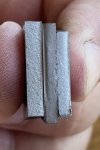Joshua Fisher
Knifemaker / Craftsman / Service Provider
- Joined
- Mar 27, 2018
- Messages
- 1,529
The first schedule I’m going to run will be 1650 to normalize then two grain refinement cycles at 1450 then hardening at 1475Thanks for checking in on thatJoshua Fisher . I should have contacted them myself, but I assumed it was all on my side. Pops is a great place and love doing business with them.
FWIW I also triedRobert Erickson 's idea and heated to forge temperature.
2000 30 minutes, oven cool to 1400, then air
1525 25 minutes, air cool
1365 15 minutes and slow cool.
1475 10 minutes, quench
It looked the same.


![20230807_204857[1].jpg 20230807_204857[1].jpg](https://www.bladeforums.com/data/attachments/1970/1970523-b7ac5dd8420d2cb5164037dde6d2b404.jpg?hash=t6xd2EINLL)